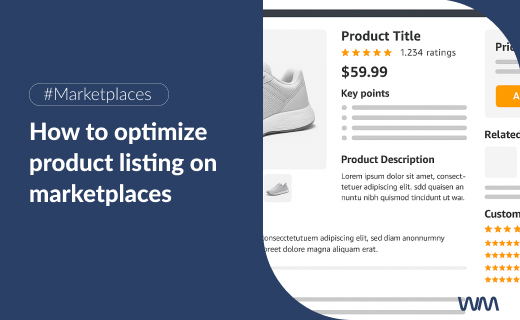Why improving your product listings is vital on marketplaces
Imagine this: a potential buyer visits Amazon looking for a product like yours. You sell it, but you haven’t taken the time to properly describe it, and the images you’ve uploaded are of poor quality. Your storefront is that second and a half—and your chance to shine is reduced to that brief moment of attention. A sloppy product page is like a poorly lit shop: no one’s going to buy. But if you optimize it well, it can bring you great results.
On Amazon, Temu, Shein, or any other marketplace, your product competes with dozens of similar ones. It’s not just about having the best price—you need to build trust, spark interest, and generate clicks that convert into sales.
Optimizing a product page is a direct investment that can boost visibility and, most importantly, drive more sales.
Images that sell
A good image doesn’t just show the product—it can win over the buyer.
Marketplaces reward listings with high-quality images. Why? Because they convert better. Well-lit sneakers, on a white background, with zoom and an extra photo of the product in use, are much more likely to build trust than a dark and blurry image.
SEO tips for images on marketplaces:
-
Use descriptive filenames, e.g.,
ergonomic-adjustable-office-chair.jpg. -
Add ALT text with relevant keywords.
-
Provide at least 5 images per product: front, back, detail, in context, and functionality.
Remember: the buyer can’t touch the product, so your image must make them feel like they already have it in their hands.
Titles with search (and buying) intent
The title is the first text both the algorithm and the customer see. It’s your only shot.
Think about how your customer searches. If you sell an ironing board, don’t just call it “Ironing Board 200.” Grab attention with something like:
“Adjustable Lightweight Steel Ironing Board”
Some tips:
-
Place the main keywords at the beginning.
-
Include brand, model, size, or standout features.
-
Don’t exceed 200 characters (Amazon), or the title will be cut off.
A good title is informative, but also persuasive.
Descriptions that persuade and solve problems
A technical description works. A description that evokes emotion sells. While you might not always be able to write emotional copy, avoid repeating what’s already in the title. Instead, use this space to tell a short story: how your product improves the customer’s life, solves a specific problem, or makes them feel something.
“Imagine starting every morning with a perfectly ironed shirt, ready in 3 minutes, wrinkle-free and stress-free. Our ironing board is designed to leave no marks, is lightweight, and makes your daily routine easier.”
Then, follow up with the technical specs. This way, you appeal to both emotional and rational buyers.
SEO bonus: include secondary related keywords like “lightweight ironing board,” “adjustable ironing board,” etc.
Bullet points and FAQs: clarity, trust, conversion
Sometimes, customers don’t want to read a paragraph. They want quick answers. That’s why you should include a bulleted description with key highlights:
-
Materials and dimensions
-
Compatibility or usage instructions
-
Warranty or key benefits
And if possible, add a Frequently Asked Questions (FAQ) section. This clarifies doubts, increases conversion, and helps you rank for long-tail keywords like “can I use this board with any iron?”
Verified reviews: your best sales tool
A customer might skip your description—but they’ll read the reviews. On marketplaces, this is one of the biggest factors influencing conversion.
Encourage your customers to leave reviews—and if possible, with real product photos.
Some marketplaces even rank products with recent reviews higher. So it’s not just about social proof—it’s an actual SEO lever.
Clear return policies: eliminate buyer hesitation
What if I don’t like it? What if it doesn’t arrive? What if it doesn’t fit?
A transparent return policy clears up all those concerns. Add a simple line like:
“Free returns within 30 days. No questions asked.”
That builds trust and boosts your conversion rate. In turn, this creates a virtuous cycle that leads to more sales and better marketplace ranking.
CTAs and related products: don’t let them leave
Your “Buy” button should be clear and visible—“Add to Cart,” “Buy Now.” But you can go further.
If you’re selling a backpack, also offer a laptop sleeve or a reusable bottle. Upselling and cross-selling work best when the customer is already convinced. Don’t miss that moment.
Bonus: also optimize your cash flow
You might have the best product listing on the marketplace, but if Amazon takes two weeks to pay you, you can’t reinvest in more inventory, ads, or growth.
Meet us—ask us how our solution lets you get paid daily, every 24 hours. That way, you improve your cash flow and scale your business faster.






